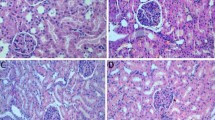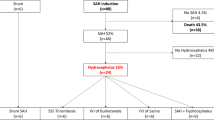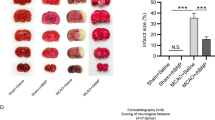Summary
The effects of centrally administered atrial natriuretic peptide (ANP) on the brain water and electrolyte contents were investigated in a rodent subarachnoid haemorrhage (SAH) model. SAH caused statistically significant increases in the brain sodium and water contents, while the potassium content did not change significantly, indicating that the brain oedema could be classified as having a primarily vasogenic component. Two μg or 5 μg of rat ANP administered into the lateral ventricle at the time of SAH induction statistically significantly decreased the water and sodium accumulation measured 90 minutes following SAH. The same treatment did not inhibit development of brain oedema measured 3 hours following SAH. However, when 5 μg of ANP was administered intraventricularly at the time of SAH induction and also 90 minutes later, the brain oedema 3 hours following SAH was again reduced statistically significantly. These effects of ANP were found not to be mediated by primary changes in serum osmolality and electrolyte concentrations.
The present results confirm that centrally administered ANP may act directly on the central nervous system to inhibit brain water and sodium accumulation in SAH-induced brain oedema. The potentials of influencing the central neuro-endocrine system as a novel way of the treatment of brain oedema are discussed.
Similar content being viewed by others
References
Barry KJ, Gogian MA, Stein BM (1979) Small animal model for investigation of subarachnoid haemorrhage and cerebral vasospasm. Stroke 10: 538–541
Beaumont K, Tan PK (1990) Effects of atrial and brain natriuretic peptides upon cyclic GMP levels, potassium transport, and receptor binding in rat astrocytes. J Neurosci Res 25: 256–262
Betz AL, Firth JA, Goldstein GW (1980) Polarity of the blood-brain barrier: distribution of enzymes between the luminal and the antiluminal membranes of brain capillary endothelial cells. Brain Res 193: 17–28
Bradbury MWB (1979) The concept of a blood-brain barrier. Wiley, New York
Buzzi GM, Moskowitz MA, Peroutka SJ, Byun B (1991) Further chracterization of the putative 5-HT receptor which mediates blockade of neurogenic plasma extravasation in rat dura mater. Br J Pharmacol 103: 1421–1428
Cserr HF, DePasquale M, Patlak CS, Pullen RGL (1989) Convection of cerebral interstitial fluid and its role in brain volume regulation. Ann New York Acad Sci 481: 123–134
De Bold AJ, Borenstein HB, Veress AT, Sonnenberg H (1981) A rapid and potent natriuretic response to intravenous injection of atrial myocardial extract in rats. Life Sci 28: 89–94
Del Bigio MR, Fedoroff S (1990) Swelling of astroglia in vitro and the effect of arginine vasopressin and atrial natriuretic peptide. Acta Neurochir (Wien) [Suppl] 51: 14–16
Dóczi T, Szerdahelyi P, Gulya K, Kiss J (1982) Brain water accumulation after the central administration of vasopressin. Neurosurgery 11: 402–407
Dóczi T, László FA, Szerdahelyi P, Joó F (1984) The role of vasopressin in brain oedema formation: further evidence obtained from the brattleboro diabetes insipidus rats with subarachnoid haemorrhage. Neursurgery 14: 436–440
Dóczi T, O'Laoire SA, Ambrose J (1984) The significance of contrast enhancement in cranial computed tomography following subarachnoid haemorrhage. J Neurosurg 60: 335–343
Dóczi T, Joó F, Ådám G, Bozóky B, Szerdahelyi P (1986) Blood-brain barrier damage after subarachnoid haemorrhage, as exemplified in a new animal model. Neurosurgery 18: 733–739
Dóczi T, Joó F, Szerdahelyi P, Bodosi M (1988) Regulation of brain water and electrolyte contents: the opposite actions of central vasopressin and atrial natriuretic factor (ANF). Acta Neurochir (Wien) [Suppl] 43: 186–188
Dóczi T, Joó F, Vecsernyés M, Bodosi M (1988) Increased concentration of atrial natriuretic factor in the cerebrospinal fluid of patients with aneurysmal subarachnoid haemorrhage and raised intracranial pressure. Neurosurgery 23: 16–19
Dóczi T, Joó F, Bodosi M (1990) Central neuroendocrine control of the brain water, electrolyte and volume homeostasis. Acta Neurochir (Wien) [Suppl] 47: 122–126
Eisenberg HM, Suddith RL (1985) Cerebral vessels have the capacity to transport sodium and potassium. Science 206: 1083–1085
Fenstermacher JD, Rapoport SI (1984) Blood-brain barrier. In: Renkin EM, Michel CC (eds) Handbook of physiology, Sect 2: the cardio-vascular system. Am Phys Soc, Bethesda, pp 969–1000
Gardner DG, Vlasuk GP, Baxter JD, Fiddes A, Lewicki JA (1987) Identification of atrial natriuretic factor gene transcripts in the central nervous system of the rat. Proc Natl Acad Sci USA 84: 2175–2179
Harik SI (1986) Blood-brain barrier sodium potassium pump: modulation by central noradrenergic innervation. Proc Natl Acad Sci USA 83: 4067–4070
Hayakawa T, Waltz AG (1975) Experimental subarachnoid haemorrhage from a middle cerebral artery; neurologic deficit, intracranial pressure, and pulse rates. Stroke 8: 417–423
Heistad DD, Kontos HA (1983) Cerebral circulation. In: Shepherd JI, Abbound FM, Geiger SR (eds) Handbook of physiology, Sect. 2: the cardiovascular system. Am Phys Soc, Bethesda, pp 137–183
Ibaragi M, Niwa M, Ozaki M (1989) Atrial natriuretic peptide modulates amiloride-sensitive Na-transport across the blood-brain barrier. J Neurochem 53: 1802–1806
Itoh H, Nakao K, Katsuura G, Morii N, Siono Y, Sakamoto M, Sugawara A, Yamada T, Matsushita A, Imura H (1986) Centrally infused atrial natriuretic polypeptide attenuates exaggerated salt appetite in spontaneously hypertensive rats. Cir Res 59: 342–347
Joó F, Temesvári P, Dux E (1983) Regulation of the macromolecular transport in the brain microvessels: the role of cyclic GMP. Brain Res 278: 165–174
Kamiya K, Kuyama L, Symon L (1982) Brain oedema in the acute stage of experimental subarachnoid haemorrhage. Proceedings of the 5th International Symposium on Brain Oedema, Groningen, pp 53–54
Karnusina T, Tóth I, Dux E, Joó F (1980) Presence of the guacylate cyclase in brain capillaries: histochemical and biochemical evidences. Brain Res 189: 588–592
Katzman R, Pappius HM (1973) Brain electrolytes and fluid metrobolism. Williams and Wilkins, Baltimore, pp 519–524
König TFR, Klippel RA (1967) The rat brain. Kriger, New York
Latzkovits L, Cserr HF, Park JT, Patlak CS, Pettigrew KD, Rimanoczy A (1993) Effects of arginine vasopressin and atriopeptin on glial cell volume measured as 3-MG space. Am J Physiol 264: C 603-C 608
Morii N, Nakao K, Sugawara A, Sakomoto M, Suda M, Shimokura M, Kiso Y, Kihara M, Yamori Y, Imura H (1985) Occurrence of atrial natriuretic polypeptyde in brain. Biochem Biophys Res Commun 127: 413–419
Nag S (1991) Effect of atrial natiuretic peptide on permeability of the blood-cerebrospinal fluid barrier. Acta Neuropathol 82: 274–279
Nakao N, Itakura T, Yokote H, Nakai K, Komai N (1990) Effect of atrial natriuretic peptide on ischemic oedema. Changes in brain water and electrolytes. Neurosurgery 27: 39–44
Naruse S, Aoki Y, Takei R, Horikawa Y, Ueda R (1991) Effects of atrial natriuretic peptide on ischaemic brain oedema in rats evaluated by proton magnetic resonance method. Stroke 22: 61–65
Needlemann P (1986) The expanding physiological roles of atrial natriuretic factor. Nature 321: 199–200
Niwa M, Ibaragi M, Tsutsumi K, Kurihara M, Himeno A, Mori K, Ozaki M (1988) Specific ANP binding sites in rat cerebral capillaries. Neurosci Lett 91: 89–94
Pappius HM (1969) Water spaces. In: Lajtha A (ed) Handbook of neurochemistry. Plenum, New York, pp 68–75
Peterson EW, Cardoso ER (1983) The blood-brain barrier following experimental subarachnoid haemorrhage. J Neurosurg 58: 738–744
Raichle ME: Hypothesis (1981) A central neuroendocrine system regulates brain ion homeostasis and volume. In: Martin JB, Reichlin S, Bick KL (eds) Neurosecretion and brain peptides. Raven, New York, pp 329–336
Rapoport SI (1976) Blood-brain barrier in physiology and medicine. Raven, New York, pp 43–152
Rodriguez EM (1976) The cerebrospinal fluid as a pathway in hte neuroendocrine integration. J Endocrinol 71: 407–443
Samson WK (1988) Central nervous system actions of atrial natriuretic factor. Brain Res Bul 20: 831–837
Shigeno T, Fritschka E, Schramm J, Brock M (1982) Cerebral oedema following experimental subarachnoid haemorrhage. In: Brock M (ed) Modern neurosurgery. Springer, Berlin Heidelberg New York, pp396–399
Skofitsch G, Jakobowits DM, Eskay RL, Zamir N (1985) Distribution of atrial natriuretic factor like-immunoreactive neurons in the brain. Neuroscience 16: 917–948
Steardo L, Nathanson JA (1987) Brain barrier tissues: end organs for atriopep. tins. Science 235: 470–473
Sudoh T, Kangawa K, Minamino N, Matsuo H (1988) Identification in porcine brain of a novel natriuretic peptide distinct from atrial natriuretic peptide. Nature (London) 332: 78–81
Symon L (1978) Disordered cerebro-vascular physiology in aneurysmal subarachnoid haemorrhage. Acta Neurochir (Wien) 4: 7–22
Trojanowski T (1982) Blood-brain barrier changes after experimental subarachnoid haemorrhage. Acta Neurochir (Wien) 60: 45–54
Tutsumi K, Niwa M, Himeno A, Kurihara M, Kawano T, Ibaragi M, Ozaki M, Mori K (1988) Alpha-atrial natriuretic peptide binding sites in the rat choroid plexus are increased in the presence of hydrocephalus. Neurosci Lett 87: 93–98
Vuolteenaho O, Arjamaa O, Ling N (1985) Atrial natriuretic polypeptides (ANP): Rat atria store high molecular weight precursor but secrete processed peptides of 25–35 amino acids. Biochem Biophys Res Commun 129: 82–88
Weinand M, O'Boynick P, Overman J (1987) The effect of central antidiuretic hormone (ADH) inhibition of vasogenic brain oedema. In: Proceeding of the 37th Congress of Neurological Surgery, Baltimore, pp 90–91
Author information
Authors and Affiliations
Additional information
Supported by Grant “OTKA I/3 2728” and “ETT T110/ 1990”.
Rights and permissions
About this article
Cite this article
Dóczi, T.P., Joó, F. & Balás, I. Atrial natriuretic peptide (ANP) attenuates brain oedema accompanying experimental subarachnoid haemorrhage. Acta neurochir 132, 87–91 (1995). https://doi.org/10.1007/BF01404853
Issue Date:
DOI: https://doi.org/10.1007/BF01404853




